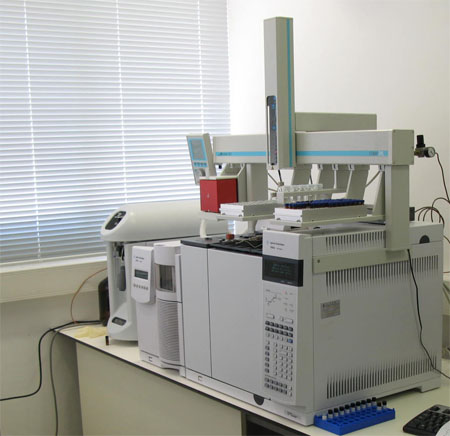The Interdepartmental Equipment Facility
Single Qudrupole GC/MS

Gas chromatography / mass spectroscopy (GC/MS) combines two analytical techniques to a single method of analyzing mixtures of chemical compounds. Gas chromatography separates the components of the mixture, and mass spectroscopy analyzes each of the components separately. GC/MS is extensively used in medical, pharmaceutical, environmental, and forensic applications.
The Agilent 5975C GC/MS combines the 5987C MSD 'Triple Axis Detector with the 7890 GC. It is further equipped with both a CTC autosampler with a headspace option, and a Tekmar Stratum Purge and Trap Concentrator .
Separation by GC is achieved by injecting the multi-component sample into a GC column. The column is coated inside with a 'stationary phase' while an inert gas flowing through the column serves as the carrier gas or 'mobile phase'. Different compounds injected as a mixture at the top of the column into this flow of carrier-gas, interact differently with the stationary coating and take different times to exit the column, where their presence is recorded by the detector. Differences in 'retention time' (RT) reflect differences in affinities of the analytes for the mobile phase and stationary phase.
At given conditions, an analyte will always elute from the column with the same RT. However, compounds with similar properties often have close, or even the same RT. Therefore, more information about compounds separated by GC is usually required to assure their identification. Such additional information, which can indeed be used to identify the analytes isolated by the GC, is supplied by the MS detector of the 5975C GC/MS.
The MS Detector
The Ion Source - Electron Ionization (EI). Analyte molecules must be electrically charged to be detected by the MS. On entering the MS detector molecules are accordingly subjected to 'Electron Ionization': they are bombarded with a stream of electrons which break each molecule apart into ionized fragments. These fragments can be large or small pieces of the original molecules.
The fragments are characterized by their mass and electrical charge and typically by their mass to charge ratio (M/Z). Since most fragments generated in the EI source have a charge of +1, the M/Z usually represents also the molecular weight of the fragment.
The Quadrupole MS filter. Ionized molecules and their fragments are next accelerated into the MS filter. The filter facilitates the identification of analytes by determining the mass to charge ratio of each ion. The Quadrupole consists of four parallel metal poles which provide between them a pathway for the ions, now accelerated by an electric field. Additional DC and RF fields send each ion in a different trajectory as it enters the quadrupole.
At a given point in time, the quadrupole is directed by the computer to allow through to the detector only fragments of specific M/Z value. The rest of the fragments are lost. The quadrupole however cycles through the different M/Z's one at a time until the whole relevant range of M/Z's is covered. This occurs many times per second; each cycle is referred to as a scan.
The computer records a graph for each scan. The x-axis represents the M/Z ratios. The y-axis represents the signal intensity (abundance) for each of the fragments detected during the scan. This graph is referred to as a mass spectrum.
The mass spectrum produced by a given chemical compound is essentially the same every time. Therefore, the mass spectrum is essentially a fingerprint of the molecule. This fingerprint can be used to identify the compound when checked against a library of mass spectra. The computer on the Agilent 5975C GC/MS has such a library of spectra that can be used to identify an unknown chemical in the sample mixture. The library compares the mass spectrum of the detected component and compares it to all the mass spectra in the library. It reports a list of likely identifications along with the statistical probability of the match.
The Purge-and-trap Concentrator
Purge-and-trap can be used for extracting and concentrating volatile organic compounds (VOCs) from almost any matrix. US EPA specifies guidelines for using purge-and-trap methods to process soil, sediment, and water samples. The technique is also used to extract VOCs from foods, plant samples etc.

This procedure is particularly useful for concentrating VOCs that are insoluble or poorly soluble in water and have boiling points below 200oC. The procedure can also be used with water soluble VOCs, but quantification limits are generally much higher for these analytes, because of their poor purging efficiency. Generally, longer purging times and heating the sample are required to increase the purging efficiency of water soluble, often polar compounds.
Adsorption. Helium gas is bubbled through the aqueous sample for several minutes, extracting the VOCs from the water into the gas phase. The gas carries the sample vapors to a trap containing adsorbing materials, which bind the VOCs.
The trap is now dry-purged with the purging gas for a set time to remove water that may have accompanied the VOCs into the trap during the purging process.
Desorption and injection. The trap is now rapidly heated to desorb the analytes, and release them back into the carrier gas stream. The transfer-line carries the analyte load to the GC and 'injects' it, in a small volume, onto the top of the GC column, ensuring good chromatographic separation of analytes. The separated analytes are sucked, one by one, into the mass spectrometer where they are detected, identified and their concentrations are measured.